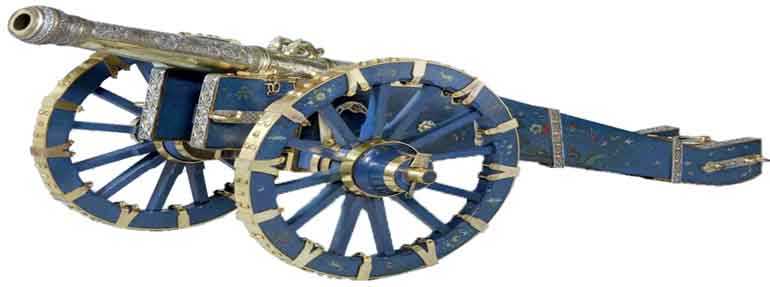Monday Mar 17, 2025
Monday Mar 17, 2025
Saturday, 8 June 2019 00:00 - - {{hitsCtrl.values.hits}}

 By Chandani Kirinde
By Chandani Kirinde
Sri Lanka could benefit from a project undertaken by the Dutch Government to look into the possibility of returning some ancient artefacts that were looted and taken away when the coastal areas of the country were under Dutch rule.
Talks between the Rijksmuseum in Amsterdam and Sri Lankan authorities were held recently in order to facilitate a joint research project which might lead to the return of several objects including a ruby-encrusted cannon which was taken as booty following a military campaign by the Dutch in 1765.
Rijksmuseum Department of History Head Martine Gosselink held talks with the Director General of the Department of National Archives, Director of National Museums, Director General of Archaeology as well as officials of the Galle Heritage Foundation among few others during a recent visit here.
“I came here to meet with Sri Lankan historians and others to set up a provenance research project together. In a later phase we can present the results during a symposium. The final report will be presented to the Minister of Culture in the Netherlands who will submit it to an advisory committee and then decide what objects will go back to Sri Lanka,” Gosselink told Daily FT.
She said her visit primarily aims to talk to historians who would like to participate in this research project. During this research they will focus on items that were ‘looted’ as there are many objects that have been legitimately acquired during that period, having been bought by art dealers and others while the king of Kandy too had gifted some objects.
“At the moment there are many questions being raised worldwide regarding contested heritage and the need to return to the former colonies objects deemed looted from them. But before we are able to do so, we have to do conduct some proper provenance research in the two countries involved: Sri Lanka as well as the Netherlands. In a later phase we should also look at how the story of our shared past can be told through these objects and if this can be done best by having these items in Sri Lanka or the Netherlands,” she said.
With regard to the items which are under discussion, Gosselink said the most interesting object that the Dutch are contemplating returning is a cannon dated somewhere around 1745 which is made of bronze, silver, gold, rubies and wood. The cannon is encrusted with the symbols of the King of Kandy on its barrel: a sun, a half moon, and the Sinhalese lion.
 It is unique as it portrays a mixture of European and Sri Lankan workmanship. The cannon was used to fire salutes to welcome the visitors of the king of Kandy.
It is unique as it portrays a mixture of European and Sri Lankan workmanship. The cannon was used to fire salutes to welcome the visitors of the king of Kandy.
It had been seized by the Dutch as booty during a military campaign in 1765 and later it had been presented to the king of their country Stadtholder Prince William V for his cabinet of rarities in The Hague. The other objects that are under discussion include two sabres (kastanes) and a knife (piha-kaetta) looted around the same period.
According to the Rijksmuseum, following an unsuccessful invasion of Kandy in 1764, the VOC troops succeeded one year later in penetrating the king’s centre of power. “Peace negotiations failed and the troops plundered the palace and the city. The booty included many costly jewels and arms, including these three ornate weapons that were possibly in the king’s personal property.”
There are also two daggers which may return to the National Museum as part of the program initiated by the Dutch Government.
Gosselink said that she would next visit Indonesia as part of the research project on objects looted from former colonies.
Discover Kapruka, the leading online shopping platform in Sri Lanka, where you can conveniently send Gifts and Flowers to your loved ones for any event including Valentine ’s Day. Explore a wide range of popular Shopping Categories on Kapruka, including Toys, Groceries, Electronics, Birthday Cakes, Fruits, Chocolates, Flower Bouquets, Clothing, Watches, Lingerie, Gift Sets and Jewellery. Also if you’re interested in selling with Kapruka, Partner Central by Kapruka is the best solution to start with. Moreover, through Kapruka Global Shop, you can also enjoy the convenience of purchasing products from renowned platforms like Amazon and eBay and have them delivered to Sri Lanka.
Discover Kapruka, the leading online shopping platform in Sri Lanka, where you can conveniently send Gifts and Flowers to your loved ones for any event including Valentine ’s Day. Explore a wide range of popular Shopping Categories on Kapruka, including Toys, Groceries, Electronics, Birthday Cakes, Fruits, Chocolates, Flower Bouquets, Clothing, Watches, Lingerie, Gift Sets and Jewellery. Also if you’re interested in selling with Kapruka, Partner Central by Kapruka is the best solution to start with. Moreover, through Kapruka Global Shop, you can also enjoy the convenience of purchasing products from renowned platforms like Amazon and eBay and have them delivered to Sri Lanka.